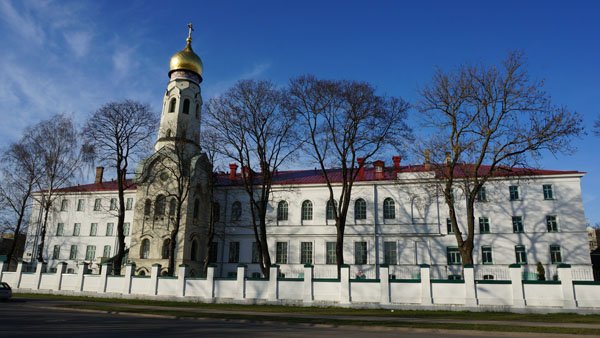Maskavas Suburb is the melting pot of Riga‘s different ethnicities. The district was developed in 19th century on the road to Moscow (hence the name). It is a mish-mash of large brick edifices and two floored wooden apartment buildings (together with art nouveau the reason of Riga‘s UNESCO inscription). Many are abandoned as Riga suffered a population decline, especially among its Russophone population.

Despite the departure of some Russians after 1990, Latvians are still a minority in the Maskavas suburb. The district has houses of worship of 5 denominations.
Russian Old Believer Grebenščikova church and monastery with its golden dome is among the largest churches in the world of this Russian schismatic community which escaped the persecutions by taking refuge in Latvia.

Jesus Heart Catholic church is Latvia‘s biggest wooden building. Neoclassical St. Alexander Nevskiy Russian Orthodox church (1825) is among Latvia’s oldest Orthodox churches.

There is also a ruined synagogue reminding of the time when Nazi Germany forced Riga‘s Jewry to live in the Maskavas suburb, eventually killing many of them (names of Latvians who helped to save some of the Jews are written in the synagogue).
Another famous sight is the Riga’s bazaar-like Central Market, established in 1930 in disused airship hangars.
Nearby Špikeri district reused old port warehouses for more upscale trade (though they are still quite empty).

Soviets used Maskavas Suburb for the tallest building in Latvia. 108 m tall Latvian Academy of Sciences dates to 1961 the Stalinist policy of erecting massive buildings of Soviet historicist style in the capitals of Soviet Republics, dedicating them to the „glory of science“. While formally respected, science was heavily censored in the Soviet Union, with many of its achievements made secret or regarded as unworthy. In summer, it is possible to ascend to the top.

At 368 m Riga TV Tower is still the tallest structure in the Baltics and the entire European Union. Located in a Daugava island in front of Maskavas Suburb, it is not formally part of it but within an easy reach. While it had a panorama restaurant, the tower‘s pyramid-like form meant that the now-closed observatory is located merely at 93 m, leading to its unpopularity.

More attractive is the nearby LIDO recreation center on the Daugava shores, famous primarily for its massive restaurant-canteen-bar, but also for a child-oriented funfair. One of the first legal post-Soviet Latvian businesses (started in 1987 when independence still seemed impossible) LIDO has a somewhat legendary status. When constructed in 1999 the Recreation center indeed felt like a miraculous addition to a Riga that still lacked malls and amusement opportunities. And while LIDO has since lost momentum and has been outflanked by other growth (much of it also adorning the shores of Daugava), it is still always full of Rigans.

Population: 32 000
Loading map...

